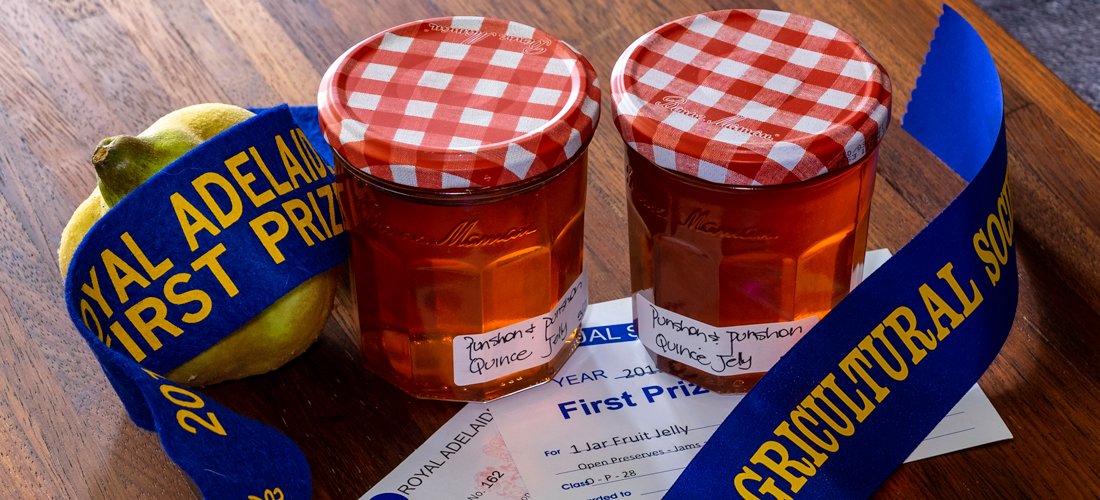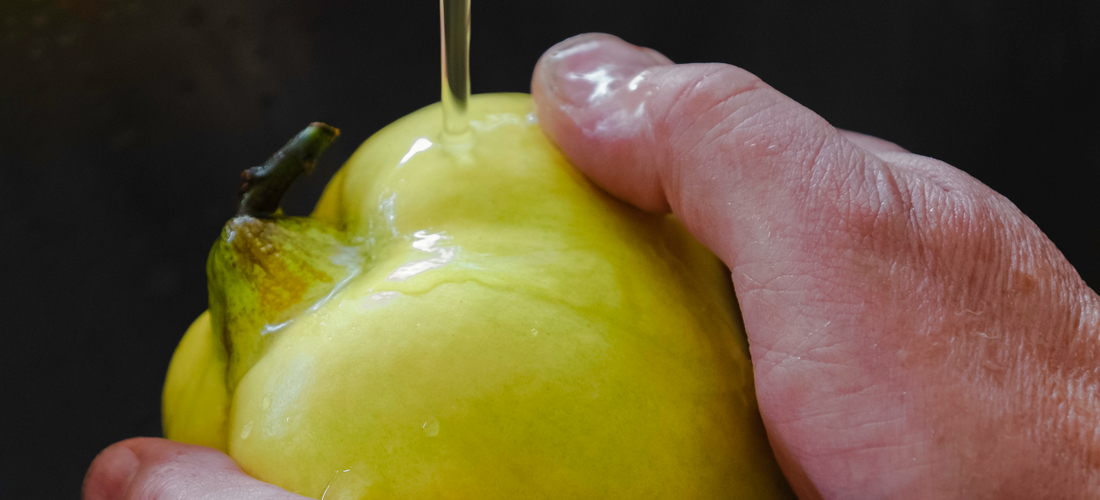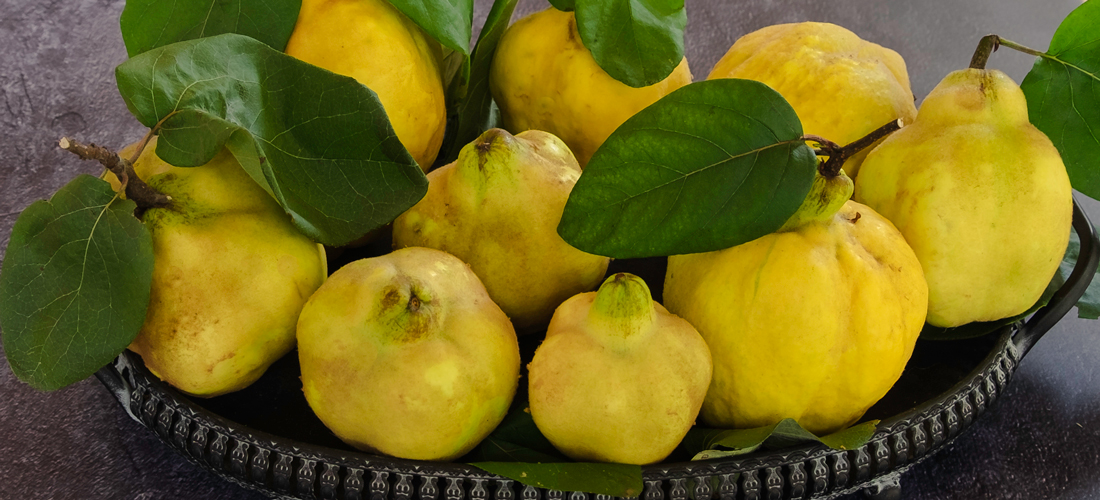Quince Jelly
- Jams, Jellies & Marmalades

Quince jelly sparkles and shines like a rare jewel that has captured the heart, soul and fragrance of quince. Transform breakfast into a special occasion by spreading on thick slices of sourdough toast or homemade crumpets, or treat yourself by spooning over vanilla bean ice cream. Making jelly requires a little more care and patience than jam making but its worth the extra effort. Long slow cooking will bring out the intense ruby colour and carefully strained juice will produce a jelly with such intensity and clarity it will delight the eye of the beholder. I have won a string of awards at Agricultural Shows with this recipe. For a special culinary gift, simply wrap with some colourful ribbon and love.
- Cooking Time:
- 1.5 hours
- Quantity:
- 8-10 x 300ml jars
INGREDIENTS
- 2 kg
- Fresh quinces
- 3 litres
- Water
- 2
- Lemons
- 500g
- Sugar, for every 500ml strained juice

METHOD
Jellies are made from strained juice from simmered fruit. The juice must be measured to calculate the amount of sugar required. This juice is then boiled with sugar until the setting point is reached.
A perfectly set jelly should quiver when spooned out of the jar.
Wipe the quinces with a dry cloth to remove the soft brown downy covering on the fruit. Remove any damaged or bruised areas and cut the quinces, without peeling or removing the pip, into large pieces approximately 4-5 cm.
Using a vegetable peeler, remove the peel from 1 lemon and juice from both lemons.
Place the quince pieces, lemon peel and juice into a large preserving pan or a large heavy bottom stainless-steel pan, and just cover the fruit with water.
Simmer gently for approximately 1-1.5 hours until the quinces are thoroughly cooked and are pulpy. The quince colour will change progressively during the cooking process from creamy light yellow to a pink/red colour.
Pour the pulp and juice into the sterilised jelly bag progressively and allow to strain a minimum of four hours but preferably overnight.
Do not squeeze the jelly bag or press the fruit down as this will cause a cloudy jelly. The juice will be luscious, fragrant, and slightly cloudy. This slightly cloudy juice is normal at this stage if the fruit was not forced. During the next cooking stage, it will clear.
Measure the juice and pour into a clean preserving pan and reheat. For every 600ml (2.5 cups) of juice, you will need 450g (2.25 cups ) sugar.
Add the sugar and stir until the sugar crystals have dissolved. Increase the heat and boil rapidly. After approximately 5 minutes start testing for the setting point using the flake, wrinkle or thermometer test. If using a thermometer this will be 104C or 220F.
-
Once the setting point is reached, skim the jelly quickly, to remove any froth (scum) from the surface. Remove the preserving pan from the heat and place on a heat resistant surface.
Use a funnel to pour into dry sterilised screw cap sealable bottles, fill to approximately 2.5cm (1 inch) from the top of the bottle and seal using your preferred method.
-
Seal jars while the jelly is hot and store in a cool dark place in the kitchen or pantry.
Allow the jam to mature for at least 2 weeks before eating.
NOTES
- Choose ripe clean fruit. Never use mouldy fruit as this will produce a poor quality jelly.
- Use fruit that is just ripe, as they have a higher pectin content than over-ripe fruit.
- Gently simmer the fruit to extract the maximum amount of pectin and to reduce excess evaporation. Cover the pan for the first half of the cooking time, to reduce evaporation, then remove the lid and complete the cooking process without it.
- Boiling of the pulp in step 5 will result in a cloudy jelly
- A jelly bag is essential to making jelly. It's easily made using heavy-duty calico, cotton flannel or close-weave nylon, multiple layers of muslin (cheesecloth) or any other material that will only allow the fruit juice to flow through. The skin, seeds and pulp must remain inside the bag.
- Secure the jelly bag tightly, using loops or very strong tape, on a stand, upturned stool or chair in a jelly bag holder or over a stainless-steel sieve. Place a bowl underneath to catch the juice as it strains.
- Fill the jelly bag progressively with fruit and leave the fruit to drain for minimum 4 hours, preferably overnight.
- Do not squeeze the bag to extract juice as this will create a cloudy jelly.
- Adding cold sugar will reduce the initial heat of the jelly, causing it to take additional time to come back to the boil. However, the longer heating will result in a deeper colour.
- Once the sugar has dissolved in the juice, boil rapidly until the jelly reaches its setting point. Rapid boiling helps to preserve the fresh fruit flavour. Long slow simmering affects the colour and reduces the flavour of the jam.
- Jellies set very quickly. Fill the jars immediately the setting point has been reached. If necessary, use a warm dry stainless steel or plastic funnel. If the jelly starts to set in the pan, return to stove and warm briefly on a low heat until it is liquid again.
- Once the jars have been filled, gently tap the jars to remove any air bubbles.
- Often a small knob of butter is added to marmalade or jam to disperse the scum. Do not use this technique with a jelly as it will make it cloudy.
- Jelly yield is lower than jam as the pulp is discarded. The final yield will depend upon the juice content of the fruit and this is influenced by the fruit’s ripeness, growing conditions and time of year. They can be stored for up to 2 years. However, it is recommended to eat up preserves before the new season.
- To clean the jelly bag - remove pulp and seeds and rinse under cold water to remove excess fruit mass. Thoroughly wash the bag, rinsing well to remove all traces of detergent. Dry completely before storing. The bag can be reused multiple times, however, sterilise it before every use.
- Sterilize the jelly bag prior to each use by scalding it with boiling water. This will also help the runs to run freely through the bag, instead of being absorbed into it.

